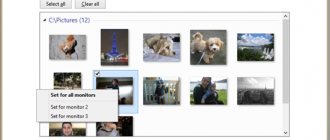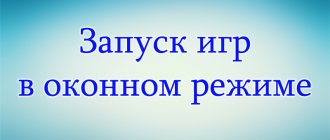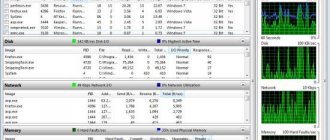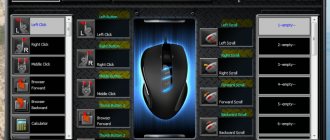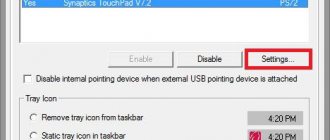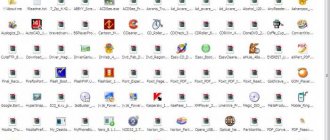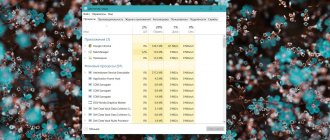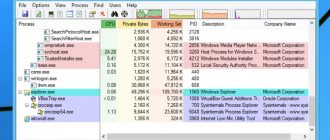Solving your mathematical problems online. The free version of the program only provides you with answers. If you want to see the complete solution, you must register for a free full trial.
Other programs
- Problem solving
- Factorization
- Asymptotes
- Inverse functions
- Matrices and systems of equations
- Derivatives
- Integrals
- Statistics
- Differential equations
Curricula work program in mathematics
Municipal budgetary educational institution
“Secondary school No. 9 with in-depth study of individual subjects”
Content
Introduction
- Planned results of mastering the academic subject
2. Contents of the academic subject.
3. Thematic planning indicating the number of hours allocated to mastering each topic
Introduction.
The program is compiled in accordance with the requirements of the Federal State Educational Standard of the second generation of basic general education in mathematics:
An approximate program for an algebra course (grades 7–9), created on the basis of a unified concept of teaching mathematics in high school, developed by A.G. Merzlyak, V.B. Polonsky, M.S. Yakir, D.A. Nomirovsky, included in the “Algorithm of Success” system (M.: Ventana-Graf, 2014) and provided teaching materials for grades 7-9 “Algebra – 7”, “Algebra – 8” and “Algebra – 9” / A.G. .Merzlyak, V.B. Polonsky, M.S. Yakir / M.: Ventana-Graf, 2014.
These documents take into account the main ideas and provisions of the Program for the development and formation of universal educational activities for basic general education. Conscious mastery by students of the system of algebraic knowledge and skills is necessary in everyday life for studying related disciplines and continuing education.
The practical significance of the school algebra course is due to the fact that its object is the quantitative relations of the real world. Mathematical training is necessary to understand the principles of the design and use of modern technology, the perception of scientific and technical concepts and ideas. Mathematics is the language of science and technology. With its help, phenomena and processes occurring in nature are modeled and studied.
Algebra is one of the core subjects of the basic school: it provides the study of other disciplines. First of all, this applies to subjects of the natural science cycle, in particular to physics and computer science. The development of students' logical thinking when teaching algebra contributes to the mastery of humanities subjects. Practical skills of an algebraic nature are necessary for the labor and professional training of schoolchildren.
The development in students of correct ideas about the essence and origin of algebraic abstractions, the relationship between the real and the ideal, the nature of how mathematical science reflects phenomena and processes of the real world, the place of algebra in the system of sciences and the role of mathematical modeling in scientific knowledge and practice contributes to the formation of students’ scientific worldview and qualities of thinking necessary for adaptation in the modern information society.
Requiring from students mental and volitional efforts, concentration, activity of a developed imagination, algebra develops moral personality traits (persistence, determination, creative activity, independence, responsibility, hard work, discipline and critical thinking) and the ability to defend their views and beliefs with reason, as well as ability to make independent decisions.
The study of algebra, functions, probability and statistics significantly broadens the horizons of students, introducing them to induction and deduction, generalization and specification, analysis and synthesis, classification and systematization, abstraction, and analogy. The active use of tasks at all stages of the educational process develops the creative abilities of schoolchildren.
Studying algebra allows you to develop skills in mental work - planning your work, finding rational ways to carry it out, critically assessing the results. In the process of studying algebra, schoolchildren must learn to express their thoughts clearly and comprehensively, concisely and succinctly, and acquire the skills of clear, accurate and competent execution of mathematical notes.
The most important task of the school algebra course is the development of students' logical thinking. The objects of mathematical inferences themselves and the rules for their construction adopted in algebra contribute to the formation of the skills to substantiate and prove judgments, provide clear definitions, develop logical intuition, briefly and clearly reveal the mechanism of logical constructions and teach their application. Thus, algebra occupies one of the leading places in the formation of scientific and theoretical thinking of schoolchildren. By revealing the internal harmony of mathematics, forming an understanding of the beauty and grace of mathematical reasoning, algebra makes a significant contribution to the aesthetic education of students.
The algebra course for grades 7–9 is basic for mathematical education and development of schoolchildren. Algebraic knowledge is necessary for studying geometry in grades 7–9, algebra and mathematical analysis in grades 10–11, as well as studying related disciplines. At the same time, the dominant ideas and provisions of the program for the development and formation of universal educational activities for basic general education are taken into account, which ensure the formation of Russian civic identity, communicative qualities of the individual and contribute to the formation of a key competence - the ability to learn.
This program is based on the Fundamental Core of the Content of General Education, the requirements for the results of mastering the educational program of basic general education, presented in the federal state educational standard of basic general education, taking into account continuity with exemplary programs for primary general education in mathematics.
The practical significance of the school algebra course for grades 7–9 is that the subject of its study is quantitative relationships and processes of the real world, described by mathematical models. In modern society, mathematical training is necessary for every person, since mathematics is present in all spheres of human activity.
One of the main goals of studying algebra is to develop thinking. In the process of studying algebra, logical and algorithmic thinking is formed, as well as such qualities of thinking as strength and flexibility, constructiveness and criticality. For adaptation in the modern information society, an important factor is the formation of a mathematical style of thinking, including induction and deduction, generalization and concretization, analysis and synthesis, classification and systematization, abstraction and analogy. T
Teaching algebra gives students the opportunity to learn how to plan their activities, evaluate them critically, make independent decisions, and defend their views and beliefs. Students, in the process of studying algebra, learn to express their thoughts clearly and comprehensively, acquire the skills of clear and competent execution of mathematical notes, while the use of mathematical language allows students to develop competent oral and written speech.
Forms in students an idea of algebra as part of universal human culture and familiarity with the history of the development of algebra as a science. Considerable attention in the presentation of the theoretical material of the course is given to its motivation, revealing the essence of basic concepts, ideas, and methods. The training is built on the basis of the theory of developmental education, which is achieved by the peculiarities of the presentation of theoretical material and exercises for comparison, analysis, highlighting the main thing, establishing connections, classification, generalization and systematization. Particular emphasis is placed on the meaningful disclosure of mathematical concepts, interpretation of the essence of mathematical methods and the scope of their application, demonstration of the possibilities of using theoretical knowledge to solve a variety of applied problems, for example, solving word problems, monetary and interest calculations, the ability to use quantitative information presented in various forms, the ability to read graphs . Awareness of the general and essential is the main basis for solving exercises. It is important to provide detailed explanations for solving typical exercises. This reveals the essence of the method, approach, and proposes an algorithm or heuristic scheme for solving exercises of a certain type.
This program is based on the pedagogical and didactic principles of variable developmental education, set out in the concept of the educational program “Prospective School”, and modern didactic and psychological trends associated with variable developmental education and the requirements of the Federal State Educational Standard.
A. Personality-oriented principles: the principle of adaptability; development principle; the principle of comfort in the learning process.
B. Culturally oriented principles: the principle of a holistic picture of the world; the principle of integrity of educational content; principle of systematicity; the principle of a semantic relationship to the world; the principle of the orienting function of knowledge; the principle of relying on culture as a worldview and as a cultural stereotype.
B. Activity-oriented principles: the principle of learning activities; the principle of controlled transition from activity in a learning situation to activity in a life situation; the principle of transition from joint educational and cognitive activity to independent activity of the student (zone of proximal development); the principle of relying on spontaneous development processes; the principle of developing the need for creativity and creative skills.
Mathematics education is a compulsory and integral part of general education at all levels of school. Teaching mathematics in primary school is aimed at achieving the following goals:
1) in the direction of personal development:
- Formation of ideas about mathematics as part of universal human culture, about the importance of mathematics in the development of civilization and modern society;
- Development of logical and critical thinking, speech culture, ability for mental experiment;
- Formation of intellectual honesty and objectivity, the ability to overcome thought stereotypes arising from everyday experience;
- Nurturing personality traits that ensure social mobility and the ability to make independent decisions;
- Formation of the qualities of thinking necessary for adaptation in the modern information society;
- Developing interest in mathematical creativity and mathematical abilities;
2) in the meta-subject direction:
- Development of ideas about mathematics as a form of description and method of understanding reality, creating conditions for acquiring initial experience in mathematical modeling;
- Formation of general methods of intellectual activity, characteristic of mathematics and which are the basis of cognitive culture, significant for various spheres of human activity;
3) in the subject area:
- Mastery of mathematical knowledge and skills necessary for continuing education, studying related disciplines, and application in everyday life;
- Creating a foundation for mathematical development, the formation of thinking mechanisms characteristic of mathematical activity.
In accordance with the requirements of the Federal State Educational Standard for Basic General Education in grades 7–9, the subject “Mathematics” is divided into two subjects: “Algebra” and “Geometry”. The total number of algebra lessons per week in grades 7–9 is 3 hours; in the year 7th - 9th grade - 102 hours each, for the 7th - 9th grade course there are only 306 hours. The distribution of teaching time between these subjects is presented in the table.
- Planned results of studying the academic subject "Algebra"
Upon completion of the course, the student should be able to:.
- Algebra – 9
When solving mathematical problems, substantiating them and checking the solution found, use knowledge about:
- properties of numerical inequalities;
- methods for solving linear inequalities;
- properties of a quadratic function;
- methods for solving quadratic inequalities;
- interval method for solving rational inequalities;
- methods for solving systems of inequalities;
- properties and graph of the function for natural n;
- definition and properties of roots of degree n;
- powers with rational exponents and their properties;
- definition and basic properties of arithmetic progression; formula for finding the sum of its first few terms;
- definition and basic properties of geometric progression; formula for finding the sum of its first few terms;
- formula for the sum of an infinite geometric progression with a denominator less than unity.
- Use the properties of numerical inequalities to transform inequalities;
- prove simple inequalities;
- solve linear inequalities;
- build a graph of a quadratic function and use it to solve problems;
- solve quadratic inequalities;
- solve rational inequalities using the interval method;
- solve systems of inequalities;
- build a graph of a function for natural n and use it to solve problems;
- find roots of degree n;
- use the properties of roots of degree n for identity transformations;
- find values of powers with rational exponents;
- solve basic problems on arithmetic and geometric progression;
- find the sum of an infinite geometric progression with a denominator less than unity;
- find solutions to “life” (competency) problems that use mathematical tools;
- create a product (the result of project activity), for the study and description of which mathematical tools are used.
2. Content of the subject
Chapter 1 Inequalities (25h).
Numerical inequalities and their properties. Termwise addition and multiplication of numerical inequalities. Linear inequalities in one variable and their systems.
The main goal is to familiarize students with the use of: inequalities for estimating the values of expressions, to develop the ability to solve linear inequalities with one variable and their systems. The properties of numerical inequalities form the basis on which the solution of linear inequalities with one variable is based. Themes about term-by-term addition and multiplication of inequalities can be used when performing simple exercises to evaluate expressions using the method of boundaries. The concepts of absolute error and approximation accuracy, relative error are introduced. The ability to conduct deductive reasoning is developed both when proving these theorems and when performing exercises to prove inequalities.
In connection with the solution of linear inequalities in one variable: the concept of numerical intervals is given, the corresponding names and notations are introduced. The consideration of systems of inequalities of one variable is preceded by familiarizing students with the concepts of intersection and union of sets.
When solving inequalities, the properties of equivalent inequalities are used, which are explained using specific examples. Particular attention should be paid to developing the ability to solve the simplest inequalities of the form ax > b, ax
This topic also considers solving systems of two linear inequalities in one variable, in particular those written as double inequalities.
Tests: 1
Chapter 2. Quadratic function (45 hours).
Function. Properties of functions. Square trinomial. Factoring a quadratic trinomial. Function y = ax2 + bx + c, its properties and graph. Power function.
The main goal is to expand information about the properties of functions, to familiarize students with the properties and graph of a quadratic function. I
At the beginning of the topic, information about functions is systematized. Basic concepts are repeated: function, argument, domain of definition of a function, graph. The concepts of increasing and decreasing functions and intervals of constant sign are given. This creates a basis for mastering the properties of quadratic and power functions, as well as for further deepening functional concepts when studying algebra and the beginnings of analysis.
A preparatory step to studying the properties of a quadratic function is also to consider the question of the quadratic trinomial and its roots, isolating the square of the binomial from the square trinomial, and factoring the quadratic trinomial.
The study of the quadratic function begins with a consideration of the function y = ax2, its properties and features of the graph, as well as other particular types of quadratic functions - the functions y = ax2 + b, y = a (x - m)2. This information is used to study the properties of a general quadratic function. It is important that students understand that the graph of the function y = ax2 + bx + c can be obtained from the graph of the function y = ax2 using two parallel translations. Techniques for constructing a graph of the function y = ax2 + bx + c are practiced using specific examples. In this case, special attention should be paid to developing in students the ability to indicate the coordinates of the vertex of a parabola, its axis of symmetry, and the direction of the branches of the parabola.
When studying this topic, the ability to find from a graph the intervals of increasing and decreasing functions, as well as intervals in which the function maintains its sign, is further developed.
Students become familiar with the properties of the power function y = xn for even and odd natural exponents n. The concept of the ith root is introduced. They get an idea of finding root values using a calculator, without having to develop any relevant skills.
Tests: 1
Whole equations. Fractional rational equations. Inequalities of the second degree with one variable. Interval method.
The main goal is to systematize and generalize information about solving integer and fractional rational equations with one variable, to develop the ability to solve inequalities of the form ax2 + bx + c > 0 or ax2 + bx + c
This topic concludes the study of rational equations in one variable. In this regard, some generalization and deepening of information about the equations is carried out. The concepts of a whole rational equation and its degree are introduced. Students are introduced to solving third- and fourth-degree equations by factoring and introducing an auxiliary variable. The method of solving equations by introducing auxiliary variables will be widely used in the future when solving trigonometric, logarithmic and other types of equations.
Information on solving fractional rational equations is expanded. Students are introduced to some special techniques for solving such equations.
Formation of skills to solve inequalities of the form ax2 + bx + + c > 0 or ax2 + bx + c
Students are introduced to the interval method, which is used to solve simple rational inequalities.
Test papers: 2
Chapter 3. Elements of applied mathematics. (26 hours)
Math modeling. Interest calculations. Approximate calculations. Basic rules of combinatorics. Relative frequency and probability of a random event. Classic definition of probability. Basic information about statistics.
The main goal is to familiarize students with the concepts of permutation, placement, combination and the corresponding formulas for calculating their number; introduce the concepts of relative frequency and probability of a random event.
Studying the topic begins with solving problems in which you need to create certain combinations of elements and count their number. The combinatorial multiplication rule is explained, which is used later in deriving formulas for calculating the number of permutations, placements and combinations. When studying this material, it is necessary to draw students’ attention to the difference between the concepts of “placement” and “combination”, to develop their ability to determine what type of combinations are being discussed in the problem.
In this topic, students are introduced to basic information from probability theory. The concepts of “random event”, “relative frequency”, “probability of a random event” are introduced. Statistical and classical approaches to determining the probability of a random event are considered. It is important to draw students' attention to the fact that the classical definition of probability can only be applied to such models of real events in which all outcomes are equally possible.
Tests: 1
Chapter 4. Number sequences (23h)
Number sequences. Arithmetic and geometric progressions. Formulas for the n-term and the sum of the first n terms of the progression. Infinitely decreasing geometric progression.
The main goal is to give concepts about arithmetic and geometric progressions as numerical sequences of a special type.
When studying the topic, the concept of a sequence is introduced, the meaning of the term “nth member of a sequence” is explained, and the ability to use index notation is developed. This information is of an auxiliary nature and is used to study arithmetic and geometric progressions.
Working with the formulas of the nth term and the sum of the first ha terms of progressions, in addition to its main purpose, allows you to repeatedly return to calculations, identity transformations, and solving equations, inequalities, and systems.
The characteristic properties of arithmetic and geometric progressions are considered, which makes it possible to expand the range of proposed problems.
Tests: 1
Repetition and systematization of educational material (21h)
Primary goal. Repeat, consolidate and generalize the basic knowledge acquired in 9th grade.
Tests: 1
Approximate thematic planning. Algebra. 9th grade (4 hours per week, total 140 hours)
| Number paragraph | Contents of educational material | Characteristics of the main types of student activities (at the level of educational activities) | |
| Chapter 1 Inequalities | 25 | ||
| 1 | Numerical inequalities | 4 | Recognize and give examples of numerical inequalities, inequalities with variables, linear inequalities with one variable, double inequalities. Formulate: definitions: comparisons of two numbers, solutions to inequalities with one variable, equivalent inequalities, solutions to a system of inequalities with one variable, domain of expression; properties of numerical inequalities, addition and multiplication of numerical inequalities Prove: properties of numerical inequalities, theorems on addition and multiplication of numerical inequalities. Solve linear inequalities. Write solutions to inequalities and their systems in the form of numerical intervals, unions, intersections of numerical intervals. Solve a system of inequalities with one variable. Evaluate the meaning of an expression. Draw numerical intervals specified by inequalities on a coordinate line |
| 2 | Basic properties of numerical inequalities | 3 | |
| 3 | Addition and multiplication of numerical inequalities. Evaluating the value of an expression | 3 | |
| 4 | Inequalities with one variable | 2 | |
| 5 | Solving inequalities with one variable. Numeric intervals | 6 | |
| 6 | Systems of linear inequalities with one variable | 6 | |
| Test No. 1 | 1 | ||
| Chapter 2 Quadratic function | 45 | ||
| 7 | Repetition and expansion of feature information | 4 | Describe the concept of a function as a rule that establishes a connection between the elements of two sets. Formulate: definitions: zero of a function; intervals of constant sign of a function; a function that increases (decreases) on a set; quadratic function; quadratic inequality; properties of a quadratic function; rules for constructing graphs of functions using transformations of the form f(x) → f(x)+а; f(x) → f(x + а); f(x) → kf(x).Build graphs of functions using transformations of the form f(x) → f(x) + a; f(x) → f(x + a); f(x) → kf(x). Graph a quadratic function. Using the graph of a quadratic function, describe its properties. Describe the schematic location of the parabola relative to the x-axis depending on the sign of the leading coefficient and the discriminant of the corresponding quadratic trinomial. Solve quadratic inequalities using the diagram of the location of the parabola relative to the x-axis. Describe the graphical method for solving a system of two equations with two variables, the substitution method and the addition method for solving a system of two equations with two variables, one of which is not linear. Solve word problems in which a system of two equations with two variables is a mathematical model of a real process, and interpret the result of solving the system |
| 8 | Function properties | 4 | |
| 9 | How to plot a graph of the function y = kf(x), if the graph of the function y = f(x) is known | 3 | |
| 10 | How to plot the functions y = f(x) + b and y = f(x + a), if the graph of the function y = f(x) is known | 4 | |
| 11 | Quadratic function, its graph and properties | 7 | |
| Test No. 2 | 1 | ||
| 12 | Solving quadratic inequalities | 7 | |
| 13 | Systems of equations with two variables | 7 | |
| 14 | Solving problems using systems of second degree equations | 7 | |
| Test No. 3 | 1 | ||
| Chapter 3 Elements of an example mathematicians | 26 | ||
| 15 | Math modeling | 4 | Give examples: mathematical models of real situations; applied problems; approximate values; use of combinatorial rules of sum and product; random events, including certain and impossible events; experiments with equally probable outcomes; presentation of statistical data in the form of tables, charts, graphs; using the probabilistic properties of surrounding phenomena. Formulate: definitions: absolute error, relative error, reliable event, impossible event; classical definition of probability; rules: combinatorial sum rule, combinatorial product rule. Describe the stages of solving an applied problem. Explain and write the compound interest formula. Conduct interest calculations using compound interest. Find the accuracy of the approximation using a table of approximate values. Use various forms of writing the approximate value of a quantity. Estimate the approximate value of a quantity. Conduct experiments with random outcomes. Explain and write down the formula for finding the frequency of a random event. Describe a statistical estimate of the probability of a random event. Find the probability of a random event in experiments with equally probable outcomes. Describe the stages of statistical research. Present information in the form of tables and diagrams. Extract information from tables and charts. Find and give examples of using statistical characteristics of a data set: mean value, mode, range, sample median |
| 16 | Interest calculations | 4 | |
| 17 | Approximate calculations | 3 | |
| 18 | Basic rules of combinatorics | 4 | |
| 19 | Frequency and probability of a random event | 2 | |
| 20 | Classic definition of probability | 4 | |
| 21 | Getting started with statistics | 4 | |
| Test No. 4 | 1 | ||
| Chapter 4 Numerical sequences | 23 | ||
| 22 | Number sequences | 3 | Give examples: sequences; number sequences, in particular arithmetic and geometric progressions; using sequences in real life; problems in which sums with an infinite number of terms are considered. Describe: the concept of a sequence, a member of a sequence, methods of specifying a sequence. Calculate the members of a sequence given by the formula of the nth term or recursively. Formulate: definitions: arithmetic progression, geometric progression; properties of the members of geometric and arithmetic progressions. Set arithmetic and geometric progressions recurrently. Write and explain formulas for the common term of arithmetic and geometric progressions. Write down and prove: formulas for the sum of the first n terms of arithmetic and geometric progressions; formulas expressing the properties of members of arithmetic and geometric progressions. Calculate the sum of an infinite geometric progression for which | q | |
| 23 | Arithmetic progression | 5 | |
| 24 | Sum of the first n terms of an arithmetic progression | 4 | |
| 25 | Geometric progression | 4 | |
| 26 | Sum of the first n terms of a geometric progression | 3 | |
| 27 | The sum of an infinite geometric progression for which | q | | 3 | |
| Test No. 5 | 1 | ||
| Repetition and systematization educational material | 21 | ||
| Exercises for reviewing the 9th grade course | 20 | ||
| Test No. 6 | 1 | ||

